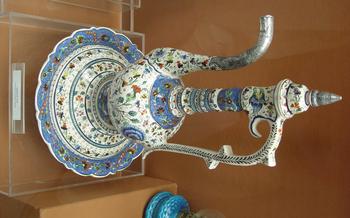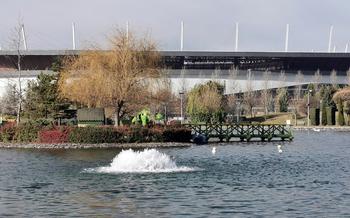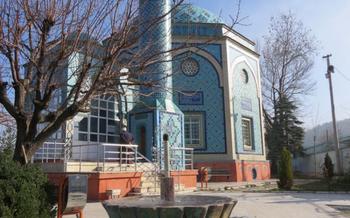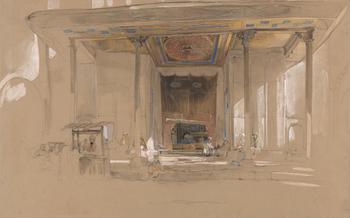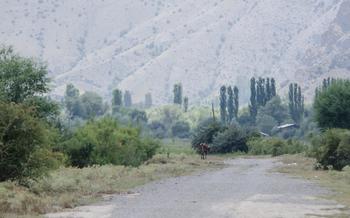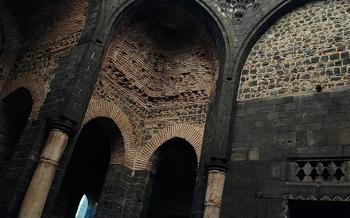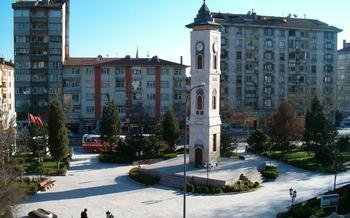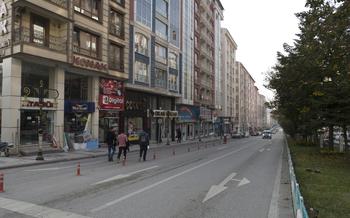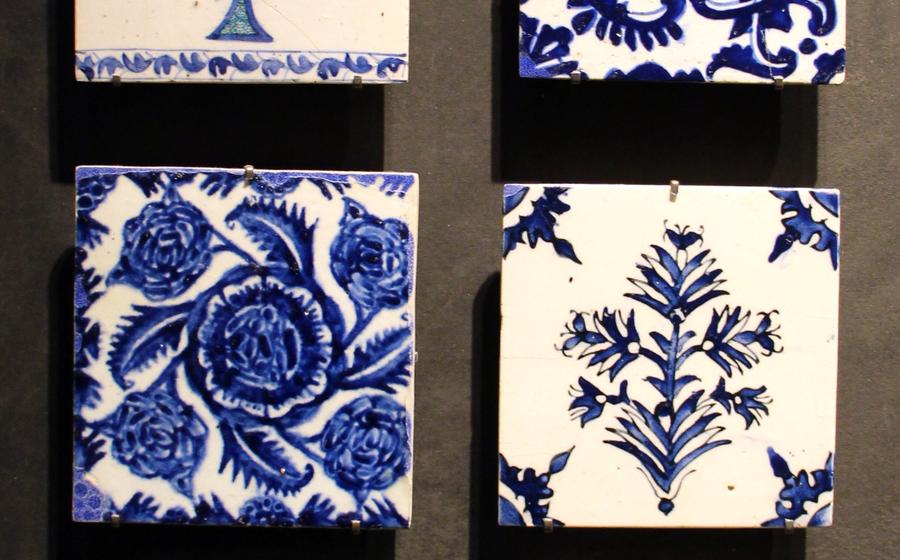
Kütahya Tile and Ceramic Museum
- History of Kütahya Tiles and Ceramics
- Techniques and Craftsmanship
- Patterns and Designs
- Kütahya Tile and Ceramic Museum: A Journey Through Artistic Legacy
- Museum Exhibits and Displays
- Guided Tours and Workshops
- Shopping for Tiles and Ceramics
- Local Cuisine and Crafts
- Cultural and Historical Context
- Social and Economic Impact:
- Sustainability and Conservation
- Festivals and Events
- Day Trips and Nearby Attractions:
- Photography Tips
- Insider Tip: Unveiling Kütahya's Hidden Treasures
History of Kütahya Tiles and Ceramics
Kütahya's tile and ceramic art has a rich and storied history, dating back to the Seljuk period in the 13th century. The city's artisans quickly gained renown for their exquisite craftsmanship, creating tiles and ceramics that adorned palaces, mosques, and other important buildings throughout the empire. The art flourished under the patronage of the Ottoman sultans, who commissioned stunning tile panels for their palaces and mosques in Istanbul and beyond. The 16th and 17th centuries marked a golden age for Kütahya's tile production, characterized by the development of intricate designs and vibrant colors that showcased the artisans' mastery. Over time, Kütahya tiles and ceramics have evolved to reflect changing artistic styles and influences, yet they remain deeply rooted in the city's cultural heritage.
Techniques and Craftsmanship
The creation of Kütahya tiles and ceramics involves a blend of traditional techniques and skilled craftsmanship. Artisans, known as "ustalar," play a vital role in preserving and passing down the knowledge and expertise required to produce these exquisite works of art. The process begins with the preparation of clay, which is sourced locally and purified to achieve the desired consistency. The clay is then shaped into various forms using molds or by hand, depending on the desired design.
Once the clay pieces have dried, they undergo a meticulous process of glazing and firing. The glazes, made from natural minerals and oxides, are carefully applied to the clay surfaces to create a smooth and lustrous finish. The colors and patterns are achieved by mixing different glazes and applying them in multiple layers. The firing process is crucial, as the tiles and ceramics are subjected to high temperatures in a kiln to achieve the desired hardness and durability.
The intricate designs and patterns on Kütahya tiles and ceramics are often hand-painted by skilled artisans. This process requires great precision and attention to detail. The artists use a variety of brushes and techniques to create the intricate patterns, often inspired by traditional motifs and symbols. The hand-painted tiles are then fired again to fuse the glaze and colors permanently onto the surface.
The result of this meticulous process is a stunning array of tiles and ceramics that showcase the talent and artistry of Kütahya's craftsmen. Each piece is unique, reflecting the individual style and creativity of the artisan who created it.
Patterns and Designs
Kütahya tiles and ceramics showcase a diverse array of distinctive patterns and motifs, reflecting the cultural influences and artistic sensibilities of the region. Geometric designs, featuring intricate arrangements of lines, shapes, and patterns, are a common feature. Floral motifs, inspired by the natural beauty of the surrounding landscape, add a touch of elegance and charm to many pieces. Calligraphic designs, incorporating verses from the Quran or poetry, lend a spiritual and cultural significance to the tiles. These patterns are not merely decorative; they often carry symbolic meanings, representing cultural beliefs and traditions. Over time, traditional designs have been adapted to modern tastes, with contemporary artists incorporating new motifs and color combinations while still respecting the heritage of the art form.
Kütahya Tile and Ceramic Museum: A Journey Through Artistic Legacy
The Kütahya Tile and Ceramic Museum stands as a testament to the rich heritage and enduring legacy of Kütahya's tile and ceramic artistry. Established in 2005, the museum is housed within the historical Kütahya Kurşunlu Madrasah, a beautiful example of Seljuk architecture that dates back to the 15th century. Its central location in the heart of Kütahya, on the historic Gürsu Street, makes it easily accessible for visitors and allows them to immerse themselves in the city's vibrant cultural tapestry.
The museum's architectural features are a sight to behold, blending traditional and modern elements seamlessly. The original madrasah structure, with its intricate stone carvings and imposing arched entrance, has been meticulously restored and integrated with contemporary design elements, creating a unique and inviting space for visitors. The museum's interior is adorned with stunning ceramic tiles and panels, providing a glimpse into the artistry that awaits within.
Museum Exhibits and Displays
The Kütahya Tile and Ceramic Museum takes visitors on a comprehensive journey through the evolution of this ancient art form. The museum's exhibits are thoughtfully curated, showcasing a diverse range of artifacts that span from ancient times to the present day. Visitors can marvel at intricate tilework from the Seljuk period, featuring geometric and floral motifs, as well as exquisite ceramics from the Ottoman era, adorned with vibrant colors and calligraphy.
Interactive displays and multimedia presentations enhance the museum experience, providing visitors with in-depth insights into the production techniques and cultural significance of Kütahya tiles and ceramics. Special exhibitions and events are organized throughout the year, featuring the works of renowned artists, historical retrospectives, and contemporary interpretations of traditional motifs. These exhibitions offer a dynamic platform for visitors to explore the diverse expressions of this timeless art form.
Guided Tours and Workshops
The Kütahya Tile and Ceramic Museum offers guided tours that provide visitors with an in-depth understanding of the exhibits and the history of Kütahya tiles and ceramics. These tours are led by knowledgeable guides who share insights into the production techniques, patterns, and cultural significance of the artifacts. Visitors can ask questions and engage in discussions, making the tour a truly interactive experience.
Additionally, the museum organizes workshops where visitors can learn the art of tile making firsthand. These workshops are conducted by experienced artisans who guide participants through the entire process, from selecting the clay to applying the intricate designs. Participants get to create their own personalized tiles, which they can take home as a unique souvenir of their visit.
Guided tours and workshops are available on a regular basis, but it is advisable to check the museum's website or contact them in advance to confirm schedules and fees. These activities offer a fantastic opportunity to gain hands-on experience and delve deeper into the world of Kütahya tiles and ceramics.
Shopping for Tiles and Ceramics
Kütahya is a shopper's paradise for those seeking authentic and high-quality tiles and ceramics. Numerous shops and galleries throughout the city offer a wide variety of products, from traditional designs to contemporary creations. To find the best pieces, it's advisable to visit the shops and galleries near the Kütahya Tile and Ceramic Museum, where you'll find a concentration of reputable dealers.
When shopping for tiles and ceramics in Kütahya, it's essential to look for pieces with intricate details, vibrant colors, and smooth finishes. Be sure to inspect each item carefully for any cracks or imperfections. Bargaining is a common practice in Turkish markets, so don't hesitate to negotiate a fair price.
Prices for tiles and ceramics in Kütahya vary depending on the size, design, and quality of the piece. Smaller tiles and simple designs are typically more affordable, while larger tiles and elaborately decorated pieces can command higher prices. It's also worth noting that hand-painted tiles are generally more expensive than machine-made ones due to the skill and time required to create them.
If you're purchasing tiles or ceramics to take home, it's important to consider how you will transport them. Some shops offer packing and shipping services, but you may also choose to transport them yourself. If you're traveling by air, it's advisable to pack your tiles or ceramics carefully in bubble wrap or foam to prevent breakage.
Local Cuisine and Crafts
Complementing the artistic treasures of the Kütahya Tile and Ceramic Museum, visitors can immerse themselves in the city's rich culinary and craft traditions. Savor the tantalizing aromas of traditional Turkish cuisine, with dishes like the delectable "fırın kebabı," a slow-cooked lamb delicacy, or the refreshing "tarhana çorbası," a tangy yogurt soup. Local restaurants and cafes near the museum offer a delightful culinary journey, allowing visitors to relish authentic flavors amidst the city's vibrant atmosphere.
Beyond its culinary delights, Kütahya is renowned for its diverse range of traditional crafts. Explore the art of carpet weaving, where intricate designs and vibrant colors bring life to handwoven masterpieces. Discover the skill of copperwork, where artisans transform ordinary metal into exquisite decorative pieces. These crafts, deeply rooted in Kütahya's cultural heritage, offer a unique opportunity to appreciate the city's artistic legacy.
To fully immerse in the local culture, combine a visit to the Kütahya Tile and Ceramic Museum with a culinary and craft exploration. Stroll through the bustling market, where vendors display an array of handcrafted treasures, from intricate tiles and ceramics to colorful carpets and gleaming copperware. Engage with local artisans, learn about their techniques, and witness their passion for preserving traditional skills. Indulge in a culinary adventure, savoring the flavors of Kütahya's cuisine while admiring the city's vibrant cultural heritage.
Cultural and Historical Context
Kütahya's tiles and ceramics are deeply rooted in the rich cultural heritage of Turkey. The region has a long and storied history, dating back to ancient civilizations, and has been a crossroads of cultures and traditions throughout the centuries. This diverse cultural heritage is reflected in the unique patterns, designs, and motifs seen in Kütahya's tiles and ceramics.
The Seljuk and Ottoman empires, which ruled over Turkey for many centuries, played a significant role in shaping the development of Kütahya's tile and ceramic industry. These empires encouraged the production of intricate and decorative tiles and ceramics, which were used to adorn palaces, mosques, and other important buildings. The designs and techniques used during this period have left a lasting legacy on Kütahya's tile and ceramic tradition.
In addition to Islamic influences, Kütahya's tiles and ceramics have also been influenced by Byzantine and Armenian artistic traditions. This cross-cultural exchange has resulted in a unique blend of styles and designs that is characteristic of Kütahya's tile and ceramic heritage.
The tiles and ceramics of Kütahya are not only beautiful works of art but also important historical artifacts. They provide valuable insights into the cultural and artistic traditions of Turkey and the region. By visiting the Kütahya Tile and Ceramic Museum and exploring the region's rich cultural heritage, visitors can gain a deeper appreciation for the beauty and significance of Kütahya's tiles and ceramics.
Social and Economic Impact:
The tile and ceramic industry in Kütahya has a profound impact on the local economy. It provides employment and income to a significant number of artisans, craftsmen, and workers involved in various stages of production, from raw material extraction to finished product creation. The industry also generates revenue through tourism, as visitors from around the world come to admire and purchase the exquisite tiles and ceramics.
Artisans play a crucial role in preserving and promoting the cultural heritage of Kütahya. Their skills and expertise are passed down from generation to generation, ensuring the continuity of traditional techniques and designs. Their work not only contributes to the local economy but also serves as a symbol of Turkish craftsmanship and artistry.
Despite its economic importance, the tile and ceramic industry in Kütahya faces several socio-economic challenges. Globalization and mass production have led to increased competition, making it difficult for traditional artisans to compete with mass-produced tiles and ceramics. The lack of formal training programs and limited access to resources further hinder the sustainability of the industry.
To address these challenges, various initiatives and efforts are underway to support and sustain the tile and ceramic industry. These include government programs aimed at providing financial assistance, training, and marketing support to artisans. Non-profit organizations and cultural institutions also play a vital role by promoting the industry through exhibitions, workshops, and educational programs.
Sustainability and Conservation
The preservation of traditional techniques and knowledge associated with Kütahya tiles and ceramics is of paramount importance. As a valuable cultural heritage, it requires collective efforts to ensure its sustainability. The tile and ceramic industry faces challenges in balancing conservation with economic development. However, there are initiatives and efforts underway to support and sustain the industry. Museums and organizations play a vital role in promoting responsible tourism and conservation practices. By raising awareness, encouraging sustainable practices, and supporting local artisans, visitors can contribute to the preservation of this unique art form.
Festivals and Events
Kütahya's vibrant tile and ceramic heritage is celebrated through a variety of annual festivals and events that offer visitors a chance to immerse themselves in the local culture and traditions. One of the most popular events is the Kütahya International Ceramics Festival, held every July. This festival brings together ceramic artists from around the world to showcase their latest creations and demonstrate their techniques. Visitors can browse and purchase unique ceramic pieces, watch live demonstrations, and participate in workshops to learn more about the art form.
Another highlight is the Kütahya Tile Art Symposium, held every September. This symposium focuses on the traditional art of tile making, with master artisans from across Turkey gathering to create stunning tile panels that are then displayed in public spaces throughout the city. Visitors can witness the creative process firsthand and learn about the history and symbolism of Kütahya tiles.
These festivals and events provide an excellent opportunity to experience the rich cultural heritage of Kütahya and to appreciate the skill and artistry of its tile and ceramic makers.
Day Trips and Nearby Attractions:
Enrich your visit to Kütahya by exploring the surrounding region, brimming with historical, natural, and cultural wonders. Just a short drive away, you'll find the awe-inspiring Phrygian Valley, home to ancient rock-cut monuments and intriguing archaeological sites. Step back in time as you wander among the ruins of Aizanoi, marveling at the grandeur of the Temple of Zeus and the well-preserved theater.
For a breathtaking natural escape, head to the scenic Lake Simav, nestled amidst lush greenery and tranquil waters. Embark on a leisurely boat tour, casting your eyes upon the picturesque landscapes that surround the lake. Alternatively, lace up your hiking boots and explore the nearby mountains, immersing yourself in the region's unspoiled beauty.
Extend your journey by visiting the neighboring cities of Afyonkarahisar and Eskişehir, each boasting unique attractions. Afyonkarahisar invites you to discover its ancient castle, thermal springs renowned for their healing properties, and the intriguing Museum of Archaeology. Eskişehir, on the other hand, captivates with its modern art scene, vibrant nightlife, and the whimsical Porsuk River, where you can enjoy a delightful gondola ride.
Plan a multi-day itinerary to make the most of your time in Kütahya and its surroundings. Choose from various transportation options, including buses, trains, and rental cars, to suit your preferences and budget. Immerse yourself in the region's rich history, stunning natural landscapes, and diverse cultural experiences, creating lasting memories to cherish.
Photography Tips
Lighting and Angles:
- Utilize natural light whenever possible, as it casts a warm and inviting glow on the tiles and ceramics.
- Position yourself perpendicular to the tiles to avoid reflections and capture the true colors and details.
- Experiment with different angles to create dynamic compositions.
Composition Techniques:
- Incorporate leading lines, such as the grout lines between tiles, to draw the viewer's eye into the image.
- Frame your shots with architectural elements or surrounding objects to create depth and context.
- Play with negative space to create a sense of balance and harmony.
Capturing Details:
- Get close to the tiles to capture the intricate patterns and textures.
- Use a macro lens if available to showcase the fine details and craftsmanship.
- Experiment with different focus points to highlight specific elements of the design.
Indoor and Workshop Photography:
- In the museum, use a tripod to stabilize your camera and avoid blurry images in low-light conditions.
- During workshops, capture the artisans at work to document the creative process.
- Ask permission before photographing people, especially when working in close quarters.
Insider Tip: Unveiling Kütahya's Hidden Treasures
Beyond the museum's walls, Kütahya holds a treasure trove of hidden gems waiting to be discovered. For those seeking a deeper immersion into the city's ceramic heritage, venture off the beaten path to explore lesser-known workshops and studios. Engage with local artisans, watch them skillfully transform clay into exquisite works of art, and perhaps even try your hand at creating your own unique tile.
One such hidden gem is the unassuming workshop of Master Craftsman Mehmet Usta, tucked away in a quiet neighborhood. With over 50 years of experience, Mehmet Usta is a true custodian of traditional techniques, creating breathtakingly intricate tiles and ceramics that seem to come alive with each stroke of his brush. Witnessing his artistry firsthand is an experience that will leave you in awe.
As you wander through Kütahya's charming streets, keep an eye out for small family-run shops that often house generations of tile-making expertise. These hidden gems offer a unique opportunity to purchase authentic, one-of-a-kind pieces that capture the essence of Kütahya's rich heritage.
For a culinary adventure, venture into the heart of the city's old quarter and savor the flavors of traditional Turkish cuisine at local restaurants. Indulge in delectable dishes that have been passed down through generations, showcasing the region's culinary heritage.
As you explore Kütahya, embrace the opportunity to connect with the locals. Their stories, traditions, and warm hospitality will enrich your journey, providing a glimpse into the heart and soul of this vibrant city.
